by James Chillcott (@MTGCritic)
Wow. For anyone interested in MTGFinance and vintage/legacy cards, Grand Prix New Jersey was an absolutely epic event, and perhaps the most important one of the year.
With 20 vendors and over 6000+ magic players in attendance, the trading floor brought some of the most pimped out collections and fattest bankrolls in the game into a unique, but short-lived micro-economy.
There were perhaps as many as 1000+ P9 cards in attendance, and the total inventory value on the floor at peak times Saturday was almost certainly in excess of 25 million USD. There was also a plethora of excellent, yet sometimes pricey side events, including such odd ducks as classics as Italian Revised Sealed and BYOP (BringYourOwnPacks) drafts. Awesome!
I couldn’t make it down from Toronto until Friday night, so I spent most of the early morning Saturday completing my vendor interviews and taking the temperature of the room.
I finished 5-4 in Day 1 of the Grand Prix, having hung in there past X-2 just to gain experience in a format where I have relatively little to none to my name. My Slivers brew was performing pretty well overall, and 2 of my lost matches had been very close indeed against UR Delver. Sunday I entered the Super Series and scrubbed out early on after some more tight matches and a blowout vs. Elves where they went off on Turn 4 after Abrupt Decaying my main deck Chalice of the Voids on 1 back to back. We were a few hours away from the Top 8 coverage period, so the time seemed ripe to put that heavy suitcase full of cards I’d dragged across the border to work.
So there I was, hanging out in a trading cluster, grinding upwards on a handful of deals (small stuff for Tundra, small stuff for ‘Goyf), and suddenly found myself musing on the Adele Penguins of Antarctica. You see, one of my more major life goals had been to visit all 7 continents before I turned 30, a goal I was able to put to rest early due to a super-accommodating girlfriend who also happened to be a stewardess with free flight access for her partner (#airfinance). One of these trips found me standing on a frozen rock no one had bothered to name, snapping pics no one would ever care about of a colony of well over a 100,000 birds. Now the funny thing about these birds is that they build these round nests out of pebbles that they run all over the island stealing from each other to manicure. So some scientists, noting this odd behavior, they decide to paint all the pebbles in the nests one day while the birds are off eating fish, and then kick back to see what happens. So they wait a while, and come back, and what do you know, every one of the damn birds has a Skittles rainbow of a nest, basically invalidating their collective efforts and painting the birds as some of the dumbest creatures on earth. Why does this matter? Good question!
It matters because binder grinding often seems far too similar to penguins stealing pebbles from each other. In the age of smartphones, a consensus price is always just a few clicks away, and many of the trades I witnessed this weekend were silly swaps of middling non-staples that neither player was acquiring for any particular reason other than because they like to trade. I witnessed endless binders full of cards no one wants get flipped through for ages and then rejected by both parties because they were both trying to unload the same cards or because they sensed that neither was ignorant enough to cough up any value. Don’t get me wrong, I’m sure plenty of folks will chime in with how awesome their trades are, but I really want to be trading up pretty hard if I’m going to spend the time to grind. Now I certainly did see some epic trades go down on the floor at NJ, but all-in-all, if folks factored in time spent vs. results, I think they’d see a lot of penguins in motion like I do.
KNOW YOUR GOALS
Enter Li. Or at least that’s what we’ll call him for the sake of his privacy and security.
He takes one look at my Japanese foils binder and says “You want my power.” He then proceeds to open this $18,000 page of cards, which he has been casually carting around the hall under his arm like it was a ham sandwich.
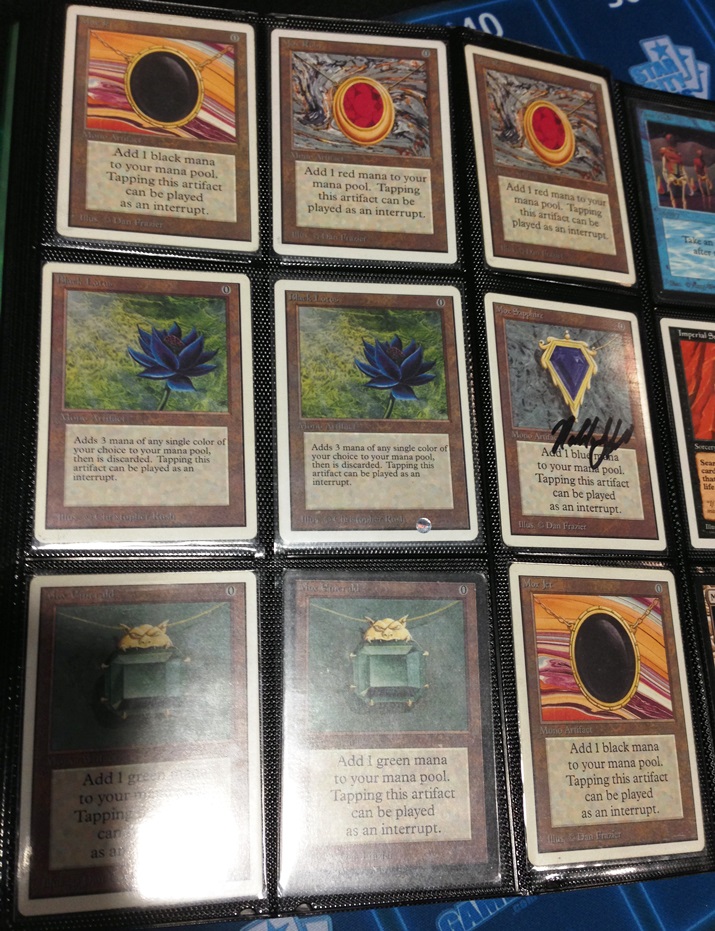
If they made light-bulbs out of dying stars, you would have seen one pop into existence over my noggin. If you follow me on Twitter or other social forums, you may be aware that one of my stated goals since shifting heavily into MTGFinance in 2012 has been to trade into some serious Power. Now this is hardly a unique goal; I mean how many of my fellow player/collectors don’t want a Black Lotus on the shelf? It’s definitely not the rarest, or the only trophy, but it’s certainly the most iconic.
And I had a plan, or at least a general strategy. Basically the goal was to trade up in the least possible number of moves, by achieving above average margins on acquisitions and trades that leveraged foresight and competent research. I almost never just randomly offer to trade cards unless I’m trying to hoard a spec or complete a deck, because I ain’t no penguin. I don’t sell to buy lists because 90% of the time the spread isn’t worth it vs my hourly rate, and I find the tracking process on spread shifts onerous. Instead I tend to go 12-120 cards deep on most of the more obvious specs, meaning the ones that seem reliable enough to yield strong returns even within the context of Ebay/Paypal fees, a platform I use to unload perhaps 60% of my specs. For example, something like M15 Hornet Queen, a card I went way deep on at .85 and flipped out by the boatload around $4-5 during it’s peak in Sep/Oct this year. Now I also buy the occasional 100 copies on nonsense like Aggressive Mining, Chasm Skulker and See the Unwritten, but only if I really like their long term chops or adopt them as pet cards to try and break them. More importantly those long shots are never allowed to exceed 5% of the portfolio to keep the ship on course.
I should point out that unless you see a really compelling deal to the contrary, it seems wise to focus on top end P9 cards where your cash flow allows. Sure, beat copies are great for Vintage players to use in decks, and some collectors are willing to have an ugly $2000 card in their collection, but if you really want to see eyes light up when you go to sell, nothing beats something that’s as pretty as it is rare.
Now I’ve had a very good year in MTGFinance but I’d be a fool if I didn’t call out Chas, Travis, Jason, Marcel, Sig, Yossarian, Nick, Corbin and the rest of the usual suspects at this point for filling in blanks, providing critique, strategy and early notice of opportunities through our collective network of MTGFinance coverage on blogs, forums and Twitter. I would have done fine on my own, but harnessing the power of many excellent minds is a truly powerful driver for success and if you want to make money and get up to speed on MTGFinance, those are the folks you should be tracking.
So unsurprisingly I was facing luggage restrictions for the event, both because large suitcases aren’t really allowed on the floor, and because I had coverage gear to haul around. So carting my entire collection of 6000+ cards to NJ was simply not an option. Selectivity was required. As such, I showed up on the floor with the following trade ammo:
- A 40-page binder of Japanese and high-end foils from the last few years. High demand highlights included Japanese Foil Thoughtseize, Treasure Cruise, Monastery Swiftspear and Dig Through Time. Many of these were bought at very attractive prices, have already seen serious gains, and were mostly purchases fueled by the sale of a rack of Modern Masters boxes that I acquired at release for $215 or so and sold for $385 less than a year later. Strong returns on SDCC 2013 sets acquired in the $320 range and sold overseas for $650-800 also drove many of the purchases. (Humbly, I should also admit to having 12 FTV 20s hanging around at a 40% loss and plenty of booster boxes and Commander 2013 decks that are only inching up so far.)
- A 4-inch binder split 70/30 between leftover KTK foreign staples and random $5-100 good stuff from Legacy forward that I’ve acquired over the years as a collector and enhanced since I got serious. Much of the “good stuff” had the additional benefit of having been bought in Canadian dollars, with an inherent discount of 10-15% vs. the US dollars I sell into, largely because our vendor and player pricing in Canada is constantly being pegged to US TCG and SCG for the most part regardless of exchange rates. Bonus!
- A half-full fat pack box containing a pile of solid staples in the $3-$40 range that I snagged from a couple of favorable dealer encounters binder diving last spring. (Full article on that over here.)
All told, I estimate that my collection value on the floor was somewhere in the neighborhood of $8K USD or so. You need to have money to make money folks. If you don’t show up with bones, you won’t be able to take action when destiny knocks.
KNOW YOUR PARTNER
When you’re trying to get something truly significant done with someone on the trading floor, you need to treat them like more than some automaton that’s randomly dispensing P9 goodies. Trades involving hundreds of cards often take a long time to complete, so you might as well take the time to get to know your partner a bit and wrap your head around what is driving their half of the deal. Are they cash strapped and looking for an exit? Do they think they know something that you don’t, about an undervalued card in your binder? Are they specialty collectors like the guy who cleaned me out of Goblin Lackey’s in pursuit of raising his tally to a new high of over 270 copies, all acquired for reasons far outside the rational?
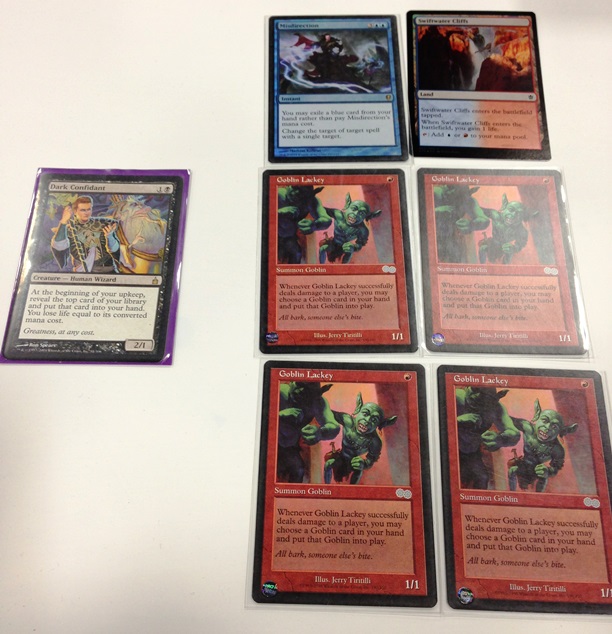
So I asked my trading partner where he was from, what he does, what he plays and I actually listened to the answers instead of dicking around with my phone. Turns out he’s a Chinese immigrant from Beijing who resides in the mid-west and acquires Modern and Legacy staples for distribution overseas. Li plays Legacy and Modern but prefers drafting and he’s been playing for 10 years. If you don’t know at least these details by the time you finish a player to player trade, you’re doing it wrong. Establishing rapport and trust early will make the tough final arguments of your deal that much easier to accomplish without anyone walking away angry. Remember, deals this big are noticed, your reputation is on the line and in a local trading ecosystem you will almost certainly be bumping into each other again.
Li went on to explain that contrary to trends in most parts of the global MTG community that typically value Russian, Korean and Japanese/German foil product in that order, China values Chinese language cards above all others, followed by English, and then Korean/Japanese further down the totem pole. In practical terms the most savvy Chinese collectors still pay attention to global valuations of course, but when dealing in non-foil Modern and Standard format staples it’s all about the native language cards. Even still, many of the older MTG sets are quite rare in China, and a growing player base and improving demographics makes for attractive margins importing English language staples, especially for cards that may never have been released there.
(He also clued me into the Pack Wars trend in China, wherein players will often blow through a booster box in an evening by cracking packs simultaneously and handing the contents over to whichever player opens the rare or mythic card with the highest casting cost. Ties are settled based on set card number with higher numbers being better. Such things have been popular sporadically in the west through Magic’s history, but never to the extent indicated to me here. The whole scene sounds like a highly addictive form of gambling WOTC wants nothing to do with, but according to my trading partner it keeps the margins on Chinese booster boxes low due to the higher turnover rate at stores where the gambling goes on. It also poisons the well on standard rares, and likely contributed directly to Li taking a pass on basically everything from Theros and KTK block other than Thoughtseize.)
TAKE YOUR TIME AND GET IT RIGHT
First and foremost when trading for P9 cards you want to make sure you’re getting the real deal, so if you have the access, I recommend arranging for professional confirmation on the consensus condition of the card(s) in question. Now many of my MTGFinance brethren may be able to spot a fake at a glance, but I haven’t traded a Lotus for over a decade so I immediately suggested we go have all of Li’s cards graded by the press-friendly staff over at the StarCityGames vendor booth.
(Side note: Kudos to SCG for running a VERY professional operation at their booth all weekend, including providing large scale color printouts of available and sold out staples, and providing quick and efficient trade service. These guys may set the high bar on price for the community, but IMHO they also set the gold standard for professionalism on the vendor side.)
I asked Stephen Green of the SCG Acquisitions team, what he looks for when assessing the veracity of vintage Magic cards.
“First off, white bordered fakes are incredibly rare. In fact, I’ve never seen one. Most of the time we get people who have tried to separate card fronts and backs and glue them back together. Often that process results in rippling or an effect that almost looks like water damage and with close inspection under a jeweler’s loupe or via the UV test we can easily spot what they’ve done. The other thing they try is to crop the sharp corners off a Collector’s Edition card, but those cards are universally off centre and in the exact same way so that’s usually a trigger to check the corners carefully, which is a test they can’t easily pass since the curve angle and jaggedness of their cut will often be quite obvious.”
We then talked a little bit about how Power cards get graded, basically reviewing the levels of wear on the front and back of magic cards that trigger various grading scales. The SCG grading guide can be found over here for reference.
We then asked Stephen to grade and price the page of P9s as though they were going up for sale on StarCityGames.com. This was his take on things from top left to bottom right in the picture above:
- Unlimited Mox Jet MP: $1000
- Unlimited Mox Ruby SP: $1000
- Unlimited Mox Ruby MP/HP: $800
- Unlimited Black Lotus NM/SP: $4000-$6000
- Unlimited Black Lotus NM: $6000+
- Unlimited Mox Sapphire MP: $1200
- Unlimited Mox Emerald NM/SP: $1100
- Beta Mox Emerald SP: $1300
- Unlimited Mox Jet MP: $800
Satisfied that I had some very juicy targets on the table, we moved back to our trading area to start working on the deal.
SET THE RULES
Nothing is more disheartening than hacking away at a serious trade with your partner for hours, only to have the whole thing fall apart over the basics.
That’s why the first thing you should do when you sit down to get the deal done is to establish the following metrics for mutual success:
- What is the definitive grade on the Power in question?
- What is the Power worth and by which measure?
- Which price guide will be used for the cards being traded into the Power?
- What discount, if any, will be applied to the “small stuff” to get the deal done? (Hint: Expect this to be a non-zero number folks).
- Reality check: Do you have the cards to get the deal done and are you emotionally prepared to let them go?
- Once these terms are agreed to, will both you and your partner stick around and complete the transaction in good faith?
In terms of grading, if the card isn’t pre-graded you are going to need info from at least two independent sources to really cover your ass. In our case we had the cooperation of SCG and several other vendors conveniently located on the show floor, but in your local area you may need to do some driving around to find a true expect to reference. Posting scans to the High End Magic Facebook group or similar can also be a good source of info if you know who to trust. If you don’t and you don’t feel like rolling the dice, it’s time to hit up Facebook or your local contacts and get some advice lined up.
In terms of the worth of the Power card(s) there are many sources, but I recommend using a number somewhere between the recent street value of player-to-player deals and the buylists of major vendors. This will likely require checking recent sales on Facebook or Ebay and comparing to posted Vendor lists. From there you can haggle a middle ground, but once you set that price, it becomes the anchor for the deal and will be hard to shift unless you can demonstrate previously unacknowledged defects in the card. Remember, there is no “right” price. There’s only the price you’re willing to pay, most likely in the form of a huge pile of cards whose prices are mostly relative as well.
Before you get any further you also need to establish the discount rate on the cards being traded up the ladder. You see, because it takes so much more effort and time to manage, sell and trade a large number of cards, and because P9 cards are exceptionally rare and in high demand, most deals where non-power is on one side of the table will involve a discount. In our case, Li had made clear up front that he valued his best Lotus at $4000, and I agreed to that number with the caveat that I wanted 2nd opinions from at least 2 dealers within $250 or we would renegotiate. On the basis that the Lotus was worth $4K, we established that my side would need to hit $5000-5300 or so to clinch the deal. (I also could have simply chosen to arrange for a wire transfer and paid cash, but that would have cut into the margin for both parties since I was looking to trade up and Li was looking to gain margin he intended to pass on to his own list of motivated buyers willing to pay top dollar for cards considered rare in their local market.)
The fourth pillar of your deal is to agree to a price guide for the cards your hoping to trade up. I recommend TCG NM Bottom 5 pricing, since I’ve never understood the silly reliance on the nonsense figure that is TCG Mid, but it’s up to you to negotiate a source you can both live with. Once you pick one, you need to agree that that’s the new bible, no matter what numbers you find there. Multiple times during our deal Li tried to lower values on cards vs. the agreed upon TCG price source. I registered my disagreement each time, but allowed the count to continue on his terms, tucking away my own count for the final round of negotiation. Sure, I could have fought each battle along the way, but then I may have lost the war, and that’s not where you want to end up.
CONSOLIDATION IS KING
Recently, I noticed a problem with my #MTGFinance spec boxes. In short, they were filling up too fast. If you’re making good calls, and not going out of your way to horde long term stuff (hint: don’t do that outside P9 and the rest of the Reserved List given existing reprint policies), a sure sign that your pace of acquisitions is outpacing your ability to sell through and claim your margins. Remember, building up on-paper value is all well and good, but you aren’t actually increasing your net worth until you sell something and claim the profits.
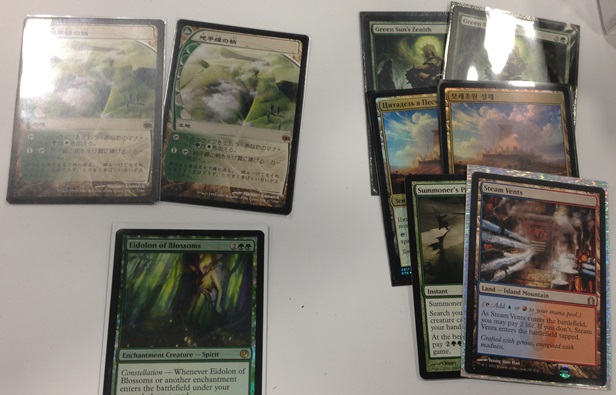
Now I already run 2 companies (Advoca.com and ShelfLife.net if you’re wondering), and enjoy a multitude of sports and social engagements, not to mention a lovely lady that generally appreciates my availability, so my rule from the beginning of this has been to try and limit my MTG spec work and research to 10 or less hours. (GPNJ was actually the first time I’ve attended a major tournament since Origins at least 8 years ago.) Some of this time spent I slot into the hobbies category and some into personal finance. At first I was only picking up a few cards here and there, but these days I’m acquiring dozens to hundreds per week, and the simple truth is that I just don’t have the time to flip them all.
And this my friends is why consolidation is king. In short, consolidating your specs means trading up from lower valued items into higher value items that will simplify your collection and make everything easier on you, from frequency of transactions to ease of finding buyers (to a point). A simple example would be to trade eleven $10 cards for a $105 card and then ten $100 cards for a $850 card. At first glance it may seem like you’re losing value here, and if you’re particularly savvy you may be able to trade straight up, but you shouldn’t be scared to subtract your usual cost of sales from the trade to get it done. This is a strategy recommended by many MTGFinance writers, and it’s a good one.
In my estimation, the sweet spot for useful P9 trade bait is around $100-$200, a card price that usually describes staple and special edition foils, dual lands and dominant legacy staples. This guideline would serve you well if you have regular access to large tournaments with high numbers of pros, vendors and lifestyle collectors in the room. If you’re more of a nowhere North Dakota guy with a single LGS for 100 miles, $20 might be your lucky number as it happily coincides with the standard and modern staples that many people won’t have full playsets of when they go looking for them. You might not nab a lot of moxes with that stuff, but you will eventually have the kind of Legacy and Modern staples that will get you closer to the end goal. However you pick your sweet spot, unless you’ve got some unique angle like Li, just trade up folks. I promise, the penguins aren’t going to mind if you swap that binder full of jank into a minty Tundra and just move on.
When attempting to acquire P9 cards from dealers, cash will often be the only language they pretend to speak, and it’s certainly the currency most likely to lower the price, but if you’re rare $100+ cards are strong enough, you may find room to dance.
In my deal with Li I took a bunch of Japanese foils and KTK staples off the table early, because he valued the former far below western rates and the latter have recently crashed and are mostly holds waiting for next fall or a breakout tourney performance to gain value. Some of my best specs were also left at home, mostly because I thought they already were facing maximum growth and I would be unlikely to trade into anything better. This maneuver proved fortuitous as it left me giving up a relatively limited amount of truly excellent cards to acquire the Lotus. The higher value pieces I put into the deal were mostly limited to the following:
- 5 Foil Japanese Thoughtseizes valued at $150/p (picked up at $110 5 months ago)
- 4 NM Revised Scrublands valued at $75 (what I paid last year)
- 1 NM Revised Tropical Island valued at $160 (snagged at $140 a few months back)
- 1 NM/SP Revised Tundra I had traded into earlier in the day, valued at $170
- 6 Foil NM Abrupt Decay valued at $80 (purchased for $45 average last winter)
- 3 Foil Snapcaster Mage valued at $120 (purchased for $90-100 last February)
- 1 Jace, The Mind Sculptor, Worldwake at $90 (pack opened)
- 1 Tarmogoyf, Future Sight at $170 (pack opened)
That small pile totaled $2460, or roughly 52% of our final deal.
The rest of my side of the trade was made up of approximately 300 or so cards in the $2-$60 range, with the biggest piles in the $15-$25 range. Cards like Thoughtseize, Ensnaring Bridge, Snapcaster Mage, various Planeswalkers, KTK Fetchlands, some mid-range Modern Masters foils, Explorations, Gravepact, Horizon Canopy, etc. There was no bulk in the deal at all, but also nothing I felt I couldn’t live without and only the Tropical Island and the Tundra needed to be pulled from my Legacy Slivers deck to help hit the total. The 30% discount we were applying seemed utterly reasonable given that 15% of my value would have been erased by Paypal/Ebay and the other 15% (or more!) would easily have been crushed by time spent trying to trade or flip 400+ cards, many of which were single copies, and/or in SP condition.
Still, getting to the final number was a grueling slog. My partner insisted on checking the price for 80% of every card he pulled out, a process that killed my phone battery and negated the chance to get a few choice pics of the process for this article, and which dragged out the deal considerably. SCG had lent us a buyer’s playmat with convenient price slots to use for the purposes of this article, and I shudder to think of how long we would have spent tallying everything otherwise. We haggled on price roughly 60% of the time but I deliberately allowed him to win 80% of those discussions so as to keep things moving along.
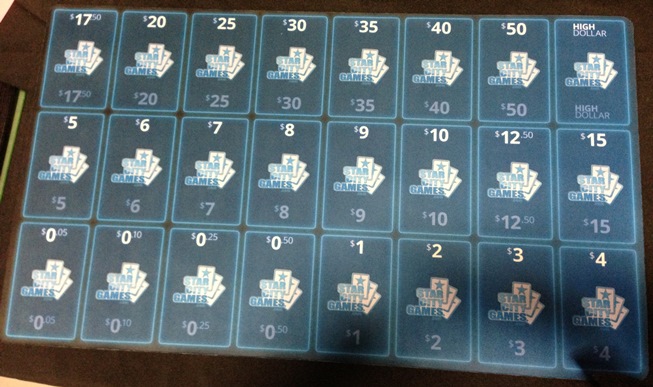
When we started to get above $4000 in agreed card value I started to protest, but Li insisted on continuing to pull cards, getting very grabby with my binders. I allowed this as well, as we were getting to the point where the items being claimed were ones that would have only ever left my specs to find homes in my EDH decks. He went back to the well on my previously rejected Japanese foils as well, and I selectively deflected some thrusts at certain cards based on what I knew I had paid. (I got my Japanese foil treasure cruises for $30 week 1 of KTK vs. $8 for my Monestary Swiftspears, so the margin boosts varied quite a bit.)
Finally, he reached for my binder one last time and I simply placed my hand on top of it and said “I’m done now, really. Let’s wrap up.” He searched my face for a new opening, but I was exhausted and reaching the end of my patience, despite my best intentions and he could see it. He went to snag my pile and bolt, but again I cut him off, informing him that now that we had a deal fully structured I wanted to get a 2nd and 3rd opinion on the veracity of the Lotus. He was incredulous but I calmly explained that it would only take 10 more minutes to erase all doubt from my mind. Li selected MTGCardMarket and they quickly and helpfully confirmed the condition, placing a lower price of around $3600 on the card when asked what they would get haggled down to on the floor. I thought this number to be low given what I’d been seeing and hearing on the floor about the rush on P9 but I wasn’t about to argue with his dealer of choice to my detriment. Kyle Lopez of Aether Games also confirmed the condition (though I declined to get a price since I was generally ok with the original number anyway) and moved back to the negotiating table.
Li now moved again for my cards. I cut him off politely, explaining that I felt he had discounted my cards twice throughout our process. The logic was simple. We had agreed to use TCG NM Low and agreed to 30%. He had offered me 20% discount on the higher end stuff like the foil Thoughtseizes and the Abrupt Decays and I had generously declined. He then proceeded to railroad me on both condition and price whenever it suited him and as I mentioned above, I hadn’t put up a fight. Now, I stated, I wanted a concession to my flexibility thus far, to take the form of the playset of foil Japanese Treasure Cruises he had been reluctant to take at first but now had in the trade pile. “You said you couldn’t move these remember? You said it was going to be banned and that it would become worthless. Your words. So now, to close the deal, I want them back. I can move them easily and they reduce my cost on this by $225-240. Take them out of my pile and we can both go get some rest before our flights.”
I could tell Li wasn’t 100% thrilled about it, but we’d come so far, and the light of the tunnel was getting brighter, so finally, with a handshake and a nod from Li, the Lotus was mine. And there I stood, a binder lighter, at lest $4-5K more liquid, and with a truly lovely NM Unlimited Black Lotus with strong immediate upside in hand.
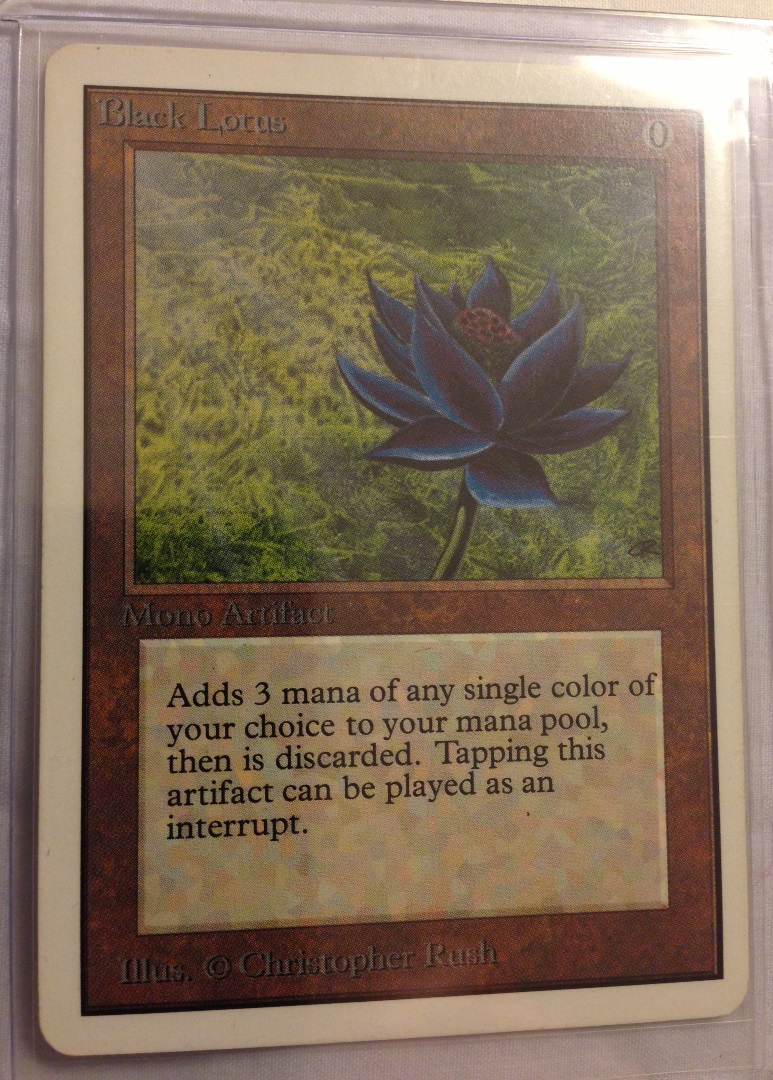
After watching the GPNJ semi-finals and finals, I did another quick walk around the room, finishing up some dealer interview business, showing off the Lotus and getting some more valuations on the card. Prices quoted were in the $3500-$6000 range, with the variance seemingly attributable to whether the vendor in question had managed to move much of their own P9 over the weekend and was in the hunt for more. Kyle at Aether Games shared a similar Lotus with me from his case that he had priced at $5K, and it seemed like a solid valuation pending the shakeout from SCG moving their buy-list on the card up immediately following the tournament.
It was hard work folks, but the prize is definitely worth it and with the experience of the trade under my belt, my interest is now peaked to delve deeper into the world of vintage speculation. Expect further articles as I settle on a new project and pursue some new goals.
Finally, much love to the entire StarCityGames staff and judges crew for running a massive and highly complex tournament with professionalism and dignity. It will be a hard event to top, but perhaps we’ll see you at GPVegas in May for the unveiling of Modern Masters 2 and the largest GP of all time?!
FINAL NOTE: When the dust settled at GPNJ, a few things became clear. A fresh round of Power 9 hoarding originating between Vintage Weekend and GPNJ is in full swing and prices are on the move. This is likely the MOST important MTGFinance event of the year and the statement has nothing to do with my immediate acquisition. I interviewed most of the dealers over the course of the weekend, and have spoken with numerous contacts on Twitter, Facebook and forums since, and the trend is clear: folks are having their P9 cards snapped up faster than ever. StarCityGames, true to their input during my deal, have moved their Sold Out price on a NM Unlimited Lotus to $8000USD. Even their Buy List price is now sitting at $5000, which means 8-8.5 graded Beta Black Lotuses sporadically found under $10K should start to dry up and reappear around $10,000-12,500 soon enough if the move on unlimited copy prices holds.
It’s important to understand that this increase in price has little at all to do with increased popularity of Vintage as a format or even any sharp upswing in basic collector activity (which takes place all the time, but rarely moves the needle due to collectors only acquiring a piece at a time). Rather, the businesses and collectors who are hoarding P9 pieces are accelerating and refining their craft, making good margins on collections that pop up online, which they buy out for cash and look to flip asap. When you keep selling out, you boost the price to test the new price plateau and the cycle continues so long as you keep moving product. Will there be room to negotiate on this stuff moving forward? Certainly. But you won’t be able to low bid your way into easy money. Those days are long over and becoming the stuff of legend. Even the $1000 Unlimited Loti of just a a few years back seems eons ago now.
So when should you move on P9 if you think you want in? Last year. Now. Not later. It’s not some bubble about to burst folks, and until the greatest card game of our generation dies across the board, these increasingly rare cards are only going up even if these new prices hold as another 6-12 month plateau.
James Chillcott is the CEO of ShelfLife.net, The Future of Collecting, Senior Partner at Advoca, a designer, adventurer, toy fanatic and an avid Magic player and collector since 1994.
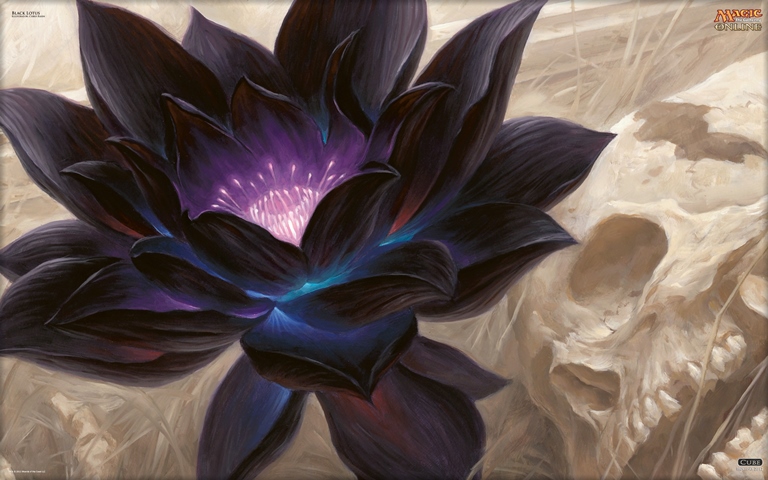
Great read 🙂
You mentioned the term TCG NM – Low as your pricing guide as opposed to TCG mid, to the average trader, could you explain how you get access to this number?
This is simply the lowest five available prices at NM, price + shipping included to a US destination. If the lowest price is far off the next four, I ignore it generally as an outlier. Otherwise I use a quick average of the first five. It’s much more representative of the actual cost of acquisition of a card in real terms.
I remember when a NM Unlimited Black Lotus was $300. If my memory serves me correct that was around 1997 – 1998.